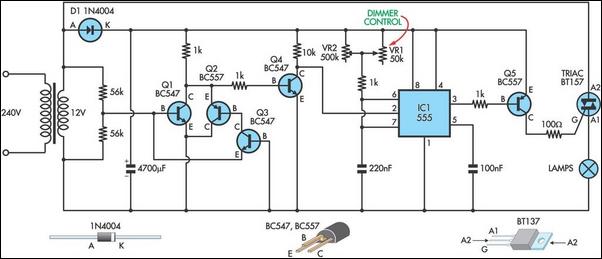Home » Circuits
Model Theatre Lighting Dimmer
This circuit is the basis for the dimmers in a model theatre lighting system which uses touch globes as the light source. The circuit is based around a 555 timer, driving a Triac. All dimmers share the one power supply and zero-crossing detector. As it will only work if there is a common AC/DC return path, it has a simple DC supply circuit consisting of one 1N4004 diode and one 4700µF capacitor. Transistors Q1 to Q3 comprise a zero-crossing detector whose output is inverted into a negative-going pulse by Q4. This pulse is fed to the trigger input (pin 2) of the 555 IC which then starts its timing period at the beginning of each mains half cycle.Circuit diagram:
The length of this period is set by capacitor C2 and the combination of resistors R6 with pots VR1 and VR2. The output of IC1 at pin 3 is then fed to transistor Q5 which inverts this signal to trigger the Triac via a 100# resistor. When the timing period is short, the Triac is turned on early in half cycle and lights are bright. Conversely, when the timing period is longer, the lights are dim or turned off. The main dimmer control is potentiometer VR1. Trimpot VR1 is used to set the range of VR1. With VR1 set fully clockwise (ie, maximum resistance) trimpot VR2 is adjusted until the lights are just turned off. The lights should then be able to be faded over the full range by the control potentiometer.
Author: Barry Freeman - Copyright: Silicon Chip Electronics

